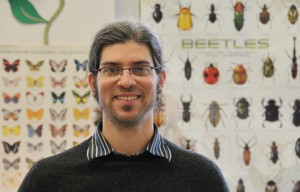Singer’s Caterpillar Defense Studies Published in Ecology, Entomology Journals

Mike Singer, associate professor of biology, associate professor of environmental studies, is the co-author of several recently-published papers. They include:
“Thee struggle for safety: effectiveness of caterpillar defenses against bird predation,” is in press and will appear in the April 2015 issue of Oikos. This article shows how the camouflaged or bold appearance of a caterpillar can protect it from predatory birds in Connecticut forests. Former BA/MA student, Isaac Lichter-Marck ’11, ’12, is the first author of this article.
“Defensive mixology: Combining acquired chemicals toward defense,” is published in Functional Ecology, 2015. This article proposes a conceptual framework to study the use of natural drug cocktails by animals and plants. Peri Mason Ph.D. ’12 is the first author of this article.
“The global distribution of diet breadth in insect herbivores,” is published in the Proceedings of the National Academy of Sciences USA, 2015. This article reports a common mathematical distribution that describes the range of dietary specificity of plant-feeding insects around the world. This research is an international collaboration among many ecologists.
“Ecological immunology mediated by diet in herbivorous insects,” published in Integrative and Comparative Biology 54, pages 913-921, 2015. This article proposes a conceptual framework to study how diet influences the immune system in plant-feeding insects, such as caterpillars. Peri Mason Ph.D. ’12 co-authored this article.
“Enemy-free space for parasitoids,” published in Environmental Entomology 43, pages 1,465-74, 2014. This article uses three case studies to argue that parasitic insects show a signature of adaptation to predation pressure, which has been an overlooked agent of evolution for parasites.
And “A mixed diet of toxic plants enables increased feeding and anti-predator defense by an insect herbivore,” published in Oecologia 176, pages 477-486, 2014. This article shows evidence that woolly bear caterpillars benefit in two ways from a diet that includes multiple toxic plant species. First, the caterpillars eat more food overall so they grow larger. Second, they become more deterrent to their predators. Peri Mason Ph.D. ’12 is the first author of this article.

